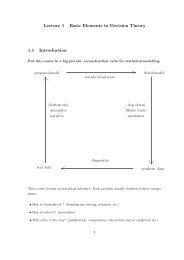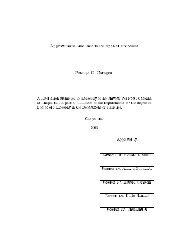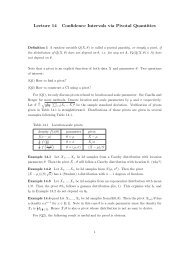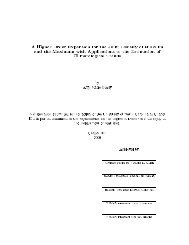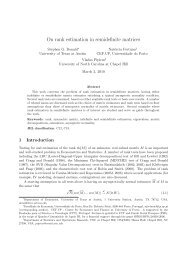Monte Carlo Methods in Statistical Mechanics: Foundations and ...
Monte Carlo Methods in Statistical Mechanics: Foundations and ...
Monte Carlo Methods in Statistical Mechanics: Foundations and ...
You also want an ePaper? Increase the reach of your titles
YUMPU automatically turns print PDFs into web optimized ePapers that Google loves.
elevant details of apparatus (program) design, comparisons with previous<br />
<strong>in</strong>vestigations, discussion of systematic errors, etc. Only if these are provided<br />
will the results be trustworthy guides to improved theoretical underst<strong>and</strong><strong>in</strong>g.<br />
2 Dynamic <strong>Monte</strong> <strong>Carlo</strong> <strong>Methods</strong>:<br />
General Theory<br />
All <strong>Monte</strong> <strong>Carlo</strong> workhas the samegeneral structure: given some probabilitymeasure<br />
on some con guration space S, wewishto generate many r<strong>and</strong>om samples from .<br />
How isthis to be done?<br />
<strong>Monte</strong> <strong>Carlo</strong> methods can be classi ed as static or dynamic. Static methods are<br />
those that generate a sequence of statistically <strong>in</strong>dependent samples from the desired<br />
probability distribution .These techniques are widely used <strong>in</strong> <strong>Monte</strong> <strong>Carlo</strong> numerical<br />
<strong>in</strong>tegration <strong>in</strong> spaces of not-too-high dimension [2]. But they are unfeasible for most<br />
applications <strong>in</strong> statistical physics <strong>and</strong>quantum eld theory,where is the Gibbs measure<br />
of some rather complicated system (extremely many coupled degrees of freedom).<br />
The idea of dynamic <strong>Monte</strong> <strong>Carlo</strong> methods is to <strong>in</strong>vent astochastic process with<br />
state space S hav<strong>in</strong>g as its unique equilibrium distribution. We then simulate this<br />
stochasticprocessonthecomputer, start<strong>in</strong>g from an arbitrary <strong>in</strong>itial con guration once<br />
the system has reached equilibrium, wemeasure time averages, which converge (as the<br />
runtimetends to <strong>in</strong> nity) to -averages. In physical terms, weare<strong>in</strong>vent<strong>in</strong>gastochastic<br />
time evolution for the given system. Let us emphasize, however, that this timeevolution<br />
need not correspond to any real \physical" dynamics: rather, the dynamics is simply a<br />
numerical algorithm, <strong>and</strong> itistobechosen, like allnumerical algorithms, on the basis<br />
of its computational e ciency.<br />
In practice, the stochastic process is always taken to beaMarkov process. So our<br />
rst order of bus<strong>in</strong>ess is to review some ofthe general theory of Markov cha<strong>in</strong>s. 2 For<br />
simplicity let us assumethatthestate space S is discrete (i.e. niteorcountably <strong>in</strong> nite).<br />
Much ofthe theory for general state space can be guessed from the discretetheory by<br />
mak<strong>in</strong>g the obvious replacements (sums by <strong>in</strong>tegrals, matrices by kernels), although the<br />
proofs tend tobeconsiderably harder.<br />
Loosely speak<strong>in</strong>g, a Markovcha<strong>in</strong> (= discrete-timeMarkov process) withstate space<br />
S is a sequence of S-valued r<strong>and</strong>om variables X0X1X2::: such that successive transitions<br />
Xt ! Xt+1 are statistically <strong>in</strong>dependent (\the future depends on the past only<br />
through the present"). More precisely, aMarkov cha<strong>in</strong> is speci ed by two <strong>in</strong>gredients:<br />
2 The books of Kemeny<strong>and</strong>Snell [4] <strong>and</strong> Iosifescu [5] are excellent references on the theory of Markov<br />
cha<strong>in</strong>s with nite state space. At a somewhat higher mathematical level, the books of Chung [6]<strong>and</strong><br />
Nummel<strong>in</strong> [7] deal with the cases of countable <strong>and</strong> general state space, respectively.<br />
3



